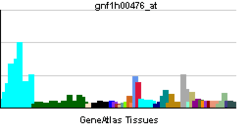COG3
| View/Edit Human | View/Edit Mouse |
Conserved oligomeric Golgi complex subunit 3 is a protein that in humans is encoded by the COG3 gene.[3][4]
The protein encoded by this gene has similarity to a yeast protein. It seems to be part of a peripheral membrane protein complex localized on cis/medial Golgi cisternae where it may participate in tethering intra-Golgi transport vesicles.[4]
Interactions
COG3 has been shown to interact with COG2[5] and COG1.[5]
References
- ↑ "Human PubMed Reference:".
- ↑ "Mouse PubMed Reference:".
- ↑ Ungar D, Oka T, Brittle EE, Vasile E, Lupashin VV, Chatterton JE, Heuser JE, Krieger M, Waters MG (Apr 2002). "Characterization of a mammalian Golgi-localized protein complex, COG, that is required for normal Golgi morphology and function". J Cell Biol. 157 (3): 405–15. doi:10.1083/jcb.200202016. PMC 2173297
 . PMID 11980916.
. PMID 11980916. - 1 2 "Entrez Gene: COG3 component of oligomeric golgi complex 3".
- 1 2 Loh, Eva; Hong Wanjin (Jun 2002). "Sec34 is implicated in traffic from the endoplasmic reticulum to the Golgi and exists in a complex with GTC-90 and ldlBp". J. Biol. Chem. United States. 277 (24): 21955–61. doi:10.1074/jbc.M202326200. ISSN 0021-9258. PMID 11929878.
Further reading
- Maruyama K, Sugano S (1994). "Oligo-capping: a simple method to replace the cap structure of eukaryotic mRNAs with oligoribonucleotides". Gene. 138 (1–2): 171–4. doi:10.1016/0378-1119(94)90802-8. PMID 8125298.
- Andersson B, Wentland MA, Ricafrente JY, et al. (1996). "A "double adaptor" method for improved shotgun library construction". Anal. Biochem. 236 (1): 107–13. doi:10.1006/abio.1996.0138. PMID 8619474.
- Yu W, Andersson B, Worley KC, et al. (1997). "Large-scale concatenation cDNA sequencing". Genome Res. 7 (4): 353–8. doi:10.1101/gr.7.4.353. PMC 139146
 . PMID 9110174.
. PMID 9110174. - Suzuki Y, Yoshitomo-Nakagawa K, Maruyama K, et al. (1997). "Construction and characterization of a full length-enriched and a 5'-end-enriched cDNA library". Gene. 200 (1–2): 149–56. doi:10.1016/S0378-1119(97)00411-3. PMID 9373149.
- Kim DW, Sacher M, Scarpa A, et al. (1999). "High-copy suppressor analysis reveals a physical interaction between Sec34p and Sec35p, a protein implicated in vesicle docking". Mol. Biol. Cell. 10 (10): 3317–29. doi:10.1091/mbc.10.10.3317. PMC 25597
 . PMID 10512869.
. PMID 10512869. - VanRheenen SM, Cao X, Sapperstein SK, et al. (1999). "Sec34p, a protein required for vesicle tethering to the yeast Golgi apparatus, is in a complex with Sec35p". J. Cell Biol. 147 (4): 729–42. doi:10.1083/jcb.147.4.729. PMC 2156162
 . PMID 10562277.
. PMID 10562277. - Suvorova ES, Kurten RC, Lupashin VV (2001). "Identification of a human orthologue of Sec34p as a component of the cis-Golgi vesicle tethering machinery". J. Biol. Chem. 276 (25): 22810–8. doi:10.1074/jbc.M011624200. PMID 11292827.
- Loh E, Hong W (2002). "Sec34 is implicated in traffic from the endoplasmic reticulum to the Golgi and exists in a complex with GTC-90 and ldlBp". J. Biol. Chem. 277 (24): 21955–61. doi:10.1074/jbc.M202326200. PMID 11929878.
- Strausberg RL, Feingold EA, Grouse LH, et al. (2003). "Generation and initial analysis of more than 15,000 full-length human and mouse cDNA sequences". Proc. Natl. Acad. Sci. U.S.A. 99 (26): 16899–903. doi:10.1073/pnas.242603899. PMC 139241
 . PMID 12477932.
. PMID 12477932. - Gevaert K, Goethals M, Martens L, et al. (2004). "Exploring proteomes and analyzing protein processing by mass spectrometric identification of sorted N-terminal peptides". Nat. Biotechnol. 21 (5): 566–9. doi:10.1038/nbt810. PMID 12665801.
- Loh E, Hong W (2004). "The binary interacting network of the conserved oligomeric Golgi tethering complex". J. Biol. Chem. 279 (23): 24640–8. doi:10.1074/jbc.M400662200. PMID 15047703.
- Dunham A, Matthews LH, Burton J, et al. (2004). "The DNA sequence and analysis of human chromosome 13". Nature. 428 (6982): 522–8. doi:10.1038/nature02379. PMC 2665288
 . PMID 15057823.
. PMID 15057823. - Gerhard DS, Wagner L, Feingold EA, et al. (2004). "The status, quality, and expansion of the NIH full-length cDNA project: the Mammalian Gene Collection (MGC)". Genome Res. 14 (10B): 2121–7. doi:10.1101/gr.2596504. PMC 528928
 . PMID 15489334.
. PMID 15489334.
This article is issued from Wikipedia - version of the 6/6/2016. The text is available under the Creative Commons Attribution/Share Alike but additional terms may apply for the media files.
